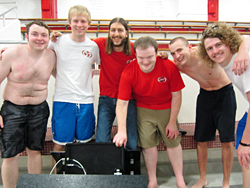Robotics Team Making Waves
It’s not easy: Designing a robot that can operate underwater, be autonomous, move through a gate, glide between buoys and use a camera to navigate. But that’s what 15 members of the Underwater Robotics Club (URC) have been grappling with since last July. And now with the national RoboSub Competition looming in San Diego on July 17, the engineers must have Seawolf V, their 65-pound robot and its microcontroller, performing in peak form. “The pressure is on,” admits URC captain Chris Thunes.
A Popular Challenge
This year’s event, cosponsored by the U.S. Office of Naval Research, is the NC State team’s seventh consecutive challenge. Thirty-five teams from the United States and abroad are competing, up from 30 teams three years ago. NC State’s team includes sophomores, juniors, seniors and Thunes, who graduated with computer science and mathematics degrees in May.

Teams qualify by having their robot perform a long task list. This includes striking two or three buoys in a given order, navigating through an obstacle course, and placing markers within designated bins. “It’s very intense,” says Matthew Wiggins, a junior in computer and electrical engineering. Last year, the NC State team was one of four finalists.
What It Takes
To remain competitive and viable the engineers have worked in the evenings and on the weekends to get the robot up and running. There have been multiple setbacks.
For instance, two Sundays ago at the Carmichael Pool, the microcontroller stopped talking to the computer, causing the robot to shut down. Then, new electronics kindly donated by Intel haven’t worked so well. “To be honest, something’s gone wrong with every pool testing,” Wiggins adds.
Added Experience
But morale remains high. One of the Seawolf V’s distinguishing qualities is its binocular vision. The team has also built this year’s robot from scratch, giving new engineers a chance to learn what robot making entails.
Thunes likens the competition to the business world. “The technical skills, the hiccups and collaboration is fantastic training and so helpful once graduating,” he says.
URC secretary Michael Brown says the contest shows him how complicated systems truly work. “You can only learn this by doing,” he says.
With less than a week to go, the team is convinced they’ll do just fine. Prize money is $5,000, enough to cover travel expenses. Wiggins says this year’s robot is even better than last year’s. “We hope to at least make the final round.”
- Categories:


